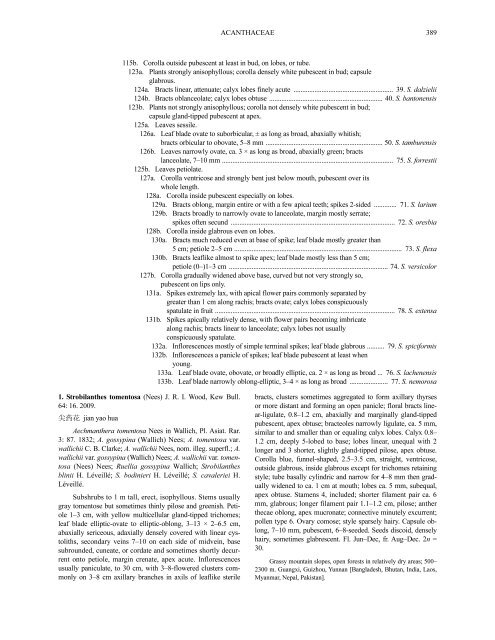Create successful ePaper yourself
Turn your PDF publications into a flip-book with our unique Google optimized e-Paper software.
ACANTHACEAE 389115b. Corolla outside pubescent at least in bud, on lobes, or tube.123a. Plants strongly anisophyllous; corolla densely white pubescent in bud; capsuleglabrous.124a. Bracts linear, attenuate; calyx lobes finely acute ......................................................... 39. S. dalzielii124b. Bracts oblanceolate; calyx lobes obtuse ................................................................. 40. S. bantonensis123b. Plants not strongly anisophyllous; corolla not densely white pubescent in bud;capsule gland-tipped pubescent at apex.125a. Leaves sessile.126a. Leaf blade ovate to suborbicular, ± as long as broad, abaxially whitish;bracts orbicular to obovate, 5–8 mm ................................................................... 50. S. tamburensis126b. Leaves narrowly ovate, ca. 3 × as long as broad, abaxially green; bractslanceolate, 7–10 mm .................................................................................................. 75. S. forrestii125b. Leaves petiolate.127a. Corolla ventricose and strongly bent just below mouth, pubescent over itswhole length.128a. Corolla inside pubescent especially on lobes.129a. Bracts oblong, margin entire or with a few apical teeth; spikes 2-sided ............. 71. S. larium129b. Bracts broadly to narrowly ovate to lanceolate, margin mostly serrate;spikes often secund .............................................................................................. 72. S. oresbia128b. Corolla inside glabrous even on lobes.130a. Bracts much reduced even at base of spike; leaf blade mostly greater than5 cm; petiole 2–5 cm ................................................................................................ 73. S. flexa130b. Bracts leaflike almost to spike apex; leaf blade mostly less than 5 cm;petiole (0–)1–3 cm ........................................................................................... 74. S. versicolor127b. Corolla gradually widened above base, curved but not very strongly so,pubescent on lips only.131a. Spikes extremely lax, with apical flower pairs commonly separated bygreater than 1 cm along rachis; bracts ovate; calyx lobes conspicuouslyspatulate in fruit ....................................................................................................... 78. S. extensa131b. Spikes apically relatively dense, with flower pairs becoming imbricatealong rachis; bracts linear to lanceolate; calyx lobes not usuallyconspicuously spatulate.132a. Inflorescences mostly of simple terminal spikes; leaf blade glabrous .......... 79. S. spiciformis132b. Inflorescences a panicle of spikes; leaf blade pubescent at least whenyoung.133a. Leaf blade ovate, obovate, or broadly elliptic, ca. 2 × as long as broad ... 76. S. lachenensis133b. Leaf blade narrowly oblong-elliptic, 3–4 × as long as broad ...................... 77. S. nemorosa1. Strobilanthes tomentosa (Nees) J. R. I. Wood, Kew Bull.64: 16. 2009.尖 药 花 jian yao huaAechmanthera tomentosa Nees in Wallich, Pl. Asiat. Rar.3: 87. 1832; A. gossypina (Wallich) Nees; A. tomentosa var.wallichii C. B. Clarke; A. wallichii Nees, nom. illeg. superfl.; A.wallichii var. gossypina (Wallich) Nees; A. wallichii var. tomentosa(Nees) Nees; Ruellia gossypina Wallich; Strobilanthesblinii H. Léveillé; S. bodinieri H. Léveillé; S. cavaleriei H.Léveillé.Subshrubs to 1 m tall, erect, isophyllous. Stems usuallygray tomentose but sometimes thinly pilose and greenish. Petiole1–3 cm, with yellow multicellular gland-tipped trichomes;leaf blade elliptic-ovate to elliptic-oblong, 3–13 × 2–6.5 cm,abaxially sericeous, adaxially densely covered with linear cystoliths,secondary veins 7–10 on each side of midvein, basesubrounded, cuneate, or cordate and sometimes shortly decurrentonto petiole, margin crenate, apex acute. Inflorescencesusually paniculate, to 30 cm, with 3–8-flowered clusters commonlyon 3–8 cm axillary branches in axils of leaflike sterilebracts, clusters sometimes aggregated to form axillary thyrsesor more distant and forming an open panicle; floral bracts linear-ligulate,0.8–1.2 cm, abaxially and marginally gland-tippedpubescent, apex obtuse; bracteoles narrowly ligulate, ca. 5 mm,similar to and smaller than or equaling calyx lobes. Calyx 0.8–1.2 cm, deeply 5-lobed to base; lobes linear, unequal with 2longer and 3 shorter, slightly gland-tipped pilose, apex obtuse.Corolla blue, funnel-shaped, 2.5–3.5 cm, straight, ventricose,outside glabrous, inside glabrous except for trichomes retainingstyle; tube basally cylindric and narrow for 4–8 mm then graduallywidened to ca. 1 cm at mouth; lobes ca. 5 mm, subequal,apex obtuse. Stamens 4, included; shorter filament pair ca. 6mm, glabrous; longer filament pair 1.1–1.2 cm, pilose; antherthecae oblong, apex mucronate; connective minutely excurrent;pollen type 6. Ovary comose; style sparsely hairy. Capsule oblong,7–10 mm, pubescent, 6–8-seeded. Seeds discoid, denselyhairy, sometimes glabrescent. Fl. Jun–Dec, fr. Aug–Dec. 2n =30.Grassy mountain slopes, open forests in relatively dry areas; 500–2300 m. Guangxi, Guizhou, Yunnan [Bangladesh, Bhutan, India, Laos,Myanmar, Nepal, Pakistan].

















